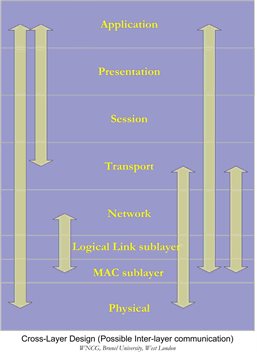Cross Layer Design
 The transition from wired to wireless networks opened up new horizons for research. There is a multitude of emerging network applications designed for personal and mobile devices. To support such a variety of applications, there is an ever growing trend to optimize the performance of the wireless networks. However, the communication stack which handles the end to end communication in data networks was initially designed for wired networks. During the transition from wired to wireless only a few protocols at the underlying layers in the communication stack were replaced with new protocols for wireless networks. In other words, the higher layers and their residing protocols remained ignorant of the fact that now they are operating without a wire. This lack of knowledge about the new protocols and different characteristics of a new physical layer (PHY) consequently caused wrong assumptions at the higher layers. While layer to layer abstraction was a goal of the layered protocol suite; in case of wireless networks it presented a few problems. In order to cope with these problems an idea of cross layer information exchange was coined in the research community. The idea behind cross layer information exchange is to use various parameters from different layers for joint optimization of protocols across the communication stack. Some of the research issues dealt with the help of Cross layer communication are:
The transition from wired to wireless networks opened up new horizons for research. There is a multitude of emerging network applications designed for personal and mobile devices. To support such a variety of applications, there is an ever growing trend to optimize the performance of the wireless networks. However, the communication stack which handles the end to end communication in data networks was initially designed for wired networks. During the transition from wired to wireless only a few protocols at the underlying layers in the communication stack were replaced with new protocols for wireless networks. In other words, the higher layers and their residing protocols remained ignorant of the fact that now they are operating without a wire. This lack of knowledge about the new protocols and different characteristics of a new physical layer (PHY) consequently caused wrong assumptions at the higher layers. While layer to layer abstraction was a goal of the layered protocol suite; in case of wireless networks it presented a few problems. In order to cope with these problems an idea of cross layer information exchange was coined in the research community. The idea behind cross layer information exchange is to use various parameters from different layers for joint optimization of protocols across the communication stack. Some of the research issues dealt with the help of Cross layer communication are:
- Application layer adaptation based on cross layer strategies.
- Cross layer design framework for real-time multimedia streaming
- Cross layer content delivery architecture
- Complexity and scalability issues in cross layer design
- Signaling for cross layer protocol interaction
- Scheduling Algorithms and Link Adaptation
- Interactions among PHY/MAC/RLC and transport layer protocol
- Cross layer adaptation for energy minimization in wireless networks
- MAC protocols with multimedia QoS support in wireless networks
- Transport/streaming protocols for end-to-end QoS support
- Applications of network coding in cross layer design
- Protocols’ implementation, analysis of correctness and efficiency, and interoperability with legacy system
- Energy saving and power control protocols for ad hoc and sensor networks
- Cross-layer strategies in 2G/3G/4G cellular system, wireless sensor, ad hoc networks and other emerging communications.
- Cross-layer design and implementation in Software defined and cognitive radio.